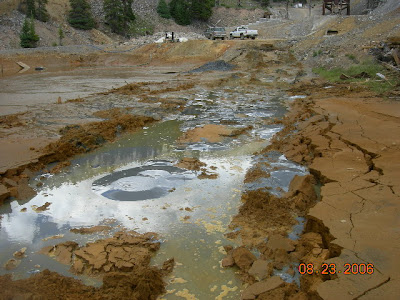I was working on this mine site where they were trying to remove a pile of mine tailings from a creekbed. Mine Tailings are the powder-sized ore waste that come out of a mine mill. They take the ore, crush it up into really small pieces, take the high grade shit to a smelter, and then pile up the powdered waste in to piles. In the old days, they'd just leave it laying around. Mine tailings are a large contributor to acid mine drainage problems.
Anyway, since at this site they had piled up the mine tailings in a creekbed, the tailings were saturated with water, and it acted like a quicksand. they were trying to remove the tailings with an excavator and a skid steer (bobcat).
The excavator and the skid steer were too heavy to drive onto the tailings, something they found out only AFTER they drove out there. the excavator sunk in over 4 feet, and the skid steer got stuck twice (once to the point where th operator couldn't get out of the cab) and had to be pulled out.
here's some snappy pictures:

Here's what it looked like right before the the excavator went into the tailings. the tailings were like this dry orange crust, that looked and felt pretty strong. we didn't realize they were saturated until after the excavator went in.

Here's the excavator driving out onto the tailings, its only sunk to about mid-tread depth or about 1 foot.

Here's the excavator trying to get out. the tailings were so deep that it had to use the arm to pull itself out, mud from the tailings had gone into the cab of the excavator, meaning that the excavator itself sunk at least 4 feet deep, and was still sinking when the operator turned to get out.
I don't have a better picture because the crew foreman didn't want me taking pictures of his operators fucking up the equipment. to be honest, they did a good job getting out, and no one knew the tailings were quicksand.

here's what the track looked like after the excavator got out. its a nice dry crust on the top, then completely saturated sediment underneath. the round sandy mounds in the front are sand boils, which commonly form after an earthquake after saturated soils and sand are shaken.
fun stuff.

No comments:
Post a Comment